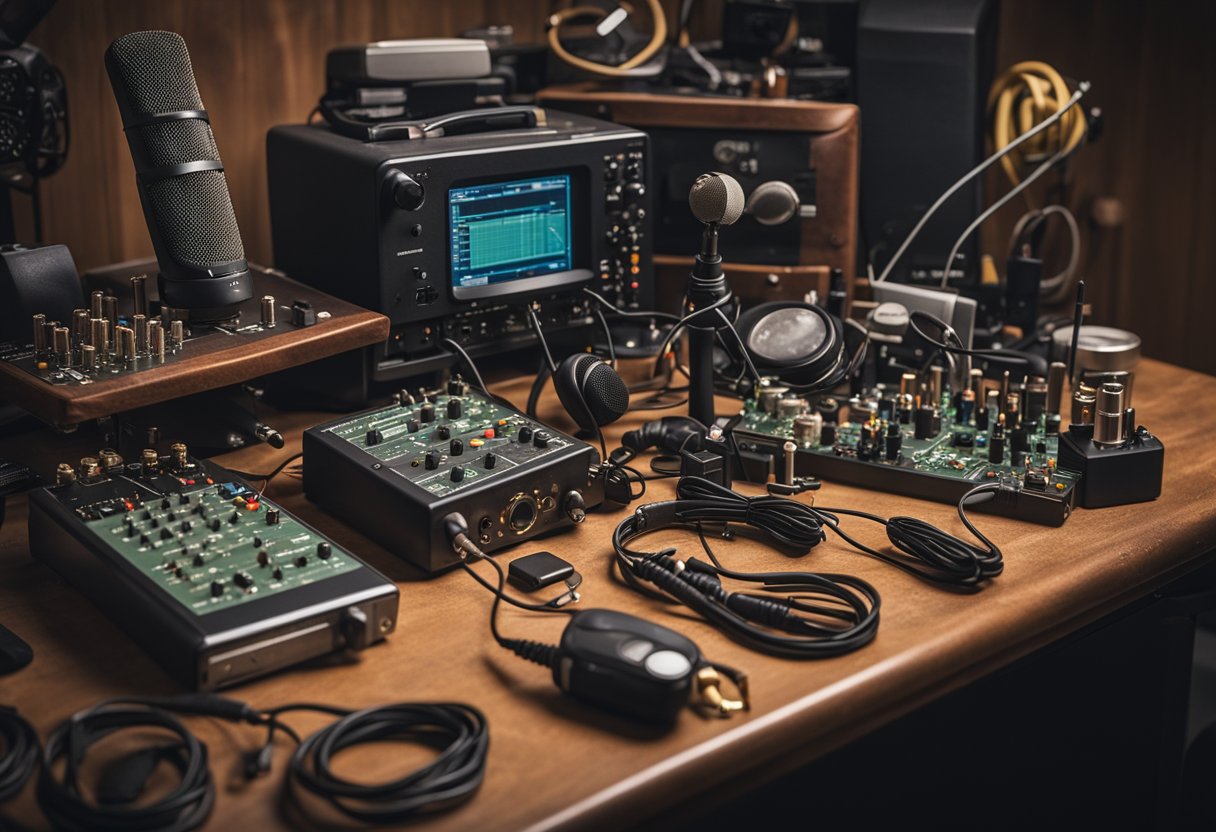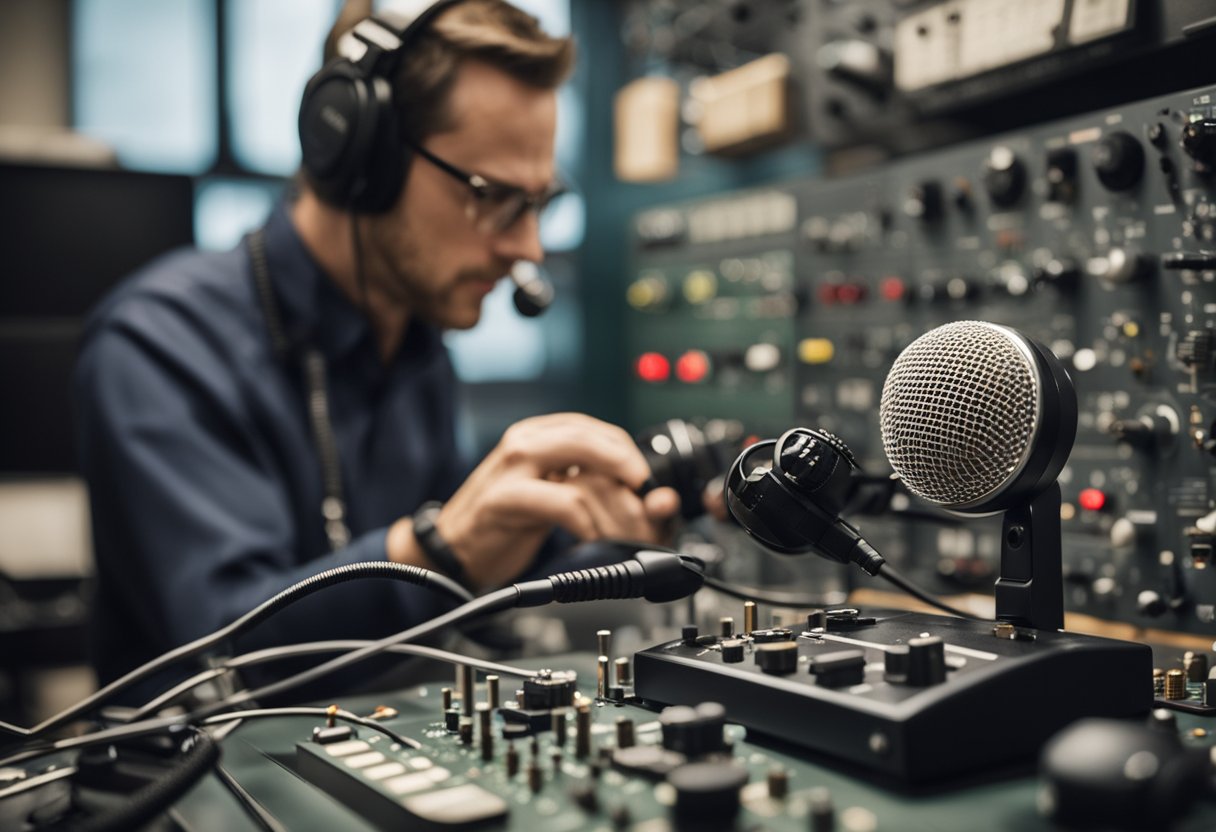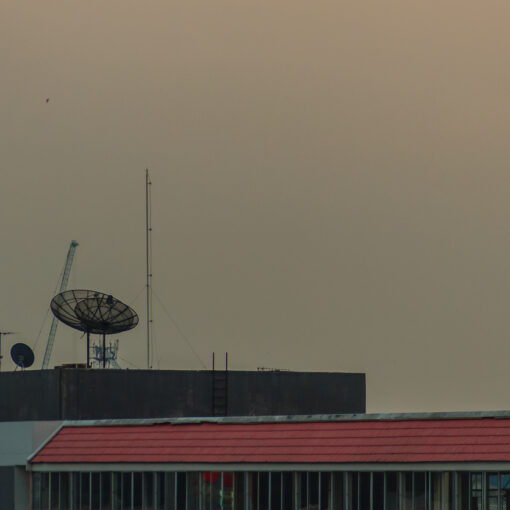Ham radio enthusiasts know that the right accessories can greatly enhance their communication experience. Whether it’s to boost signal strength, ensure clear audio, or simply make operations more convenient, there’s a broad range of add-ons available.
From microphones and speakers to antennas and power supplies, each accessory plays a crucial role in how effectively one can operate their ham radio setup. Quality equipment is key for both performance and longevity, leading operators to seek out the best accessories in the market.


Understanding what makes an accessory essential is just the beginning. For the seasoned ham radio aficionado, it involves delving into the specifics of each piece of equipment to determine how it fits into their particular setup.
For the newcomer, it’s about learning which accessories will provide a solid foundation for a growing ham radio hobby. Practicality, quality, and legal considerations all factor into the decision-making process, making it important to be well-informed before making any purchases. This ensures not only an improved ham radio experience but also adherence to all regulations.
Key Takeaways
- The right accessories can significantly improve the ham radio experience.
- Quality and practicality are crucial when selecting ham radio equipment.
- Legal considerations must be factored into the selection of ham radio accessories.
Understanding Ham Radio Basics


Before delving into the world of ham radio accessories, it is essential to grasp the fundamentals of ham radio operation and the legalities involved. Understanding the basics provides a foundation for effective and responsible communication.
Ham Radios and Frequency Fundamentals
Ham radios are devices that enable users to communicate over various radio frequencies. They are distinct from standard consumer radios in that they operate across a wide spectrum of frequency bands.
These frequency bands are regulated by authorities like the Federal Communications Commission (FCC) and are allocated specifically for amateur radio use.
The most commonly used frequency ranges in ham radio are:
- High Frequency (HF) – Ideal for long-distance communication
- Very High Frequency (VHF) – Suited for local and regional contacts
- Ultra High Frequency (UHF) – Typically used for urban environments where buildings may obstruct signals
Every frequency has its own characteristics that make it appropriate for different forms of communication. For example, some frequencies are better suited for bouncing off the ionosphere for long-distance communication, while others are ideal for line-of-sight contact.
Licensing and Call Signs
Licensing is a mandatory step to become a legitimate ham radio operator. The FCC requires prospective operators to pass an examination that ensures they understand basic regulations, operating practices, and electronics theory.
Once licensed, individuals are assigned a unique call sign, which serves as their radio identity. It is a legal requirement to identify oneself using this call sign during transmissions.
The FCC offers different levels of licenses, each granting privileges across various frequency bands:
- Technician License – Access to all amateur radio frequencies above 30 MHz
- General License – Includes privileges on certain HF bands, which are highly coveted for long-distance communications
- Amateur Extra License – Grants access to all amateur frequency privileges
These regulations and structured licensing ensure that ham radio operators respect the shared use of the radio frequencies and maintain a standard of communication that is universally understood and accepted within the amateur radio community.
Essential Ham Radio Accessories
The efficacy of a ham radio setup hinges significantly on the quality and compatibility of its accessories. Antennas and power supplies, in particular, are non-negotiable elements for any amateur radio enthusiast, impacting everything from signal range to operational uptime.
Antennas and Their Impact on Range
The antenna is a vital component of ham radio equipment. It greatly influences the range and clarity of communication.
Selecting the right antenna is crucial, as it determines how well signals can be transmitted and received over distances.
Vertical antennas are known for their omnidirectional capabilities, widely used for local communications, while directional antennas, such as Yagi-Uda arrays, target transmissions over longer distances with greater precision. Ham Radio Planet provides a comprehensive guide on antennas, whilst Radio Chronicles emphasizes their role in optimizing communication.
Power Supplies and Battery Life
Reliable power supplies are critical for consistent ham radio operations.
Whether it’s a base station or a portable setup, one needs a stable power source to ensure uninterrupted communication.
Battery life is particularly important for field operators or during emergency situations, where power outages are common.
The use of renewable energy sources, like solar panels, can supplement power supplies and prolong battery life.
Additionally, having a high-capacity battery bank is advisable for extended operations without access to the main power grid. QRPworks offers specialized ham radio accessories that cater to power needs, especially for low-power (QRP) operations.
Choosing Quality Equipment
When looking for ham radio equipment, it’s vital to prioritize devices and accessories that excel in quality, portability, and sound clarity to ensure effective communication.
Let’s delve into selecting premium handheld units and fundamental accessories that enhance functionality.
Selecting the Right Handheld Ham Radio
The Baofeng UV-5R is a cost-effective choice, known for its versatility and satisfactory power output for new ham radio enthusiasts. It’s compact, making it highly portable, but those looking for a substantial upgrade might consider the Baofeng BF-F8HP, which offers higher power output and a more robust build.
For durability and advanced features, the Yaesu FT-60R is a reliable unit with exceptional sound quality.
Another top-tier option for those desiring cutting-edge technology and GPS features is the Kenwood TH-D74A, which is also equipped with APRS functionality.
Lastly, for those seeking seamless integration with their home station, the Icom ID-5100A presents a sophisticated choice with its intuitive touchscreen display and dual-band capabilities.
Important Accessories for Functionality
Upgrading your ham radio station with pivotal accessories can dramatically improve overall performance. To start:
- Antennas: An investment in a high-quality antenna, tailored to the frequency of interest, can lead to a significant boost in signal strength and reception clarity.
- Power Supply: Ensuring a reliable and consistent power source is fundamental, with an appropriately rated power supply for your specific rig.
- Microphones and Headsets: One should not underestimate the impact of an upgraded microphone or headset. These accessories are crucial for maintaining clear audio quality in various operating conditions.
Enhancing Communication Experience
To ensure a superior ham radio operation, enthusiasts must consider integrating advanced accessories that amplify their unit’s capabilities.
This entails not only broadening the scope of communication but also embracing features that promote user-friendly interaction and reliable connections.
Advanced Features for Operators
Modern ham radios come equipped with dual-band functionality enabling operators to access two different frequency ranges simultaneously.
This allows for more versatile communication techniques and the ability to manage interference more effectively.
Features like Automatic Packet Reporting System (APRS) and built-in GPS enhance the overall experience by providing real-time data on positioning, which is invaluable for tracking and emergency reporting.
Furthermore, the integration of Bluetooth technology simplifies the process of connecting with other devices, making the setup more efficient and less cumbersome.
Boosting Signal and Connection Capabilities
The success of any ham radio communication is deeply rooted in signal strength and clarity.
Using an upgraded antenna can dramatically improve the ability to send and receive signals, especially for conversations over long distances.
It’s also crucial to note the importance of a local repeater for boosting the range and quality of communication.
Repeaters receive signals and retransmit them at higher power, which allows for seamless connectivity even when obstacles could potentially disrupt the connection.
By investing in high-quality antennas and understanding the strategic placement and use of repeaters, operators can significantly enhance their radio’s performance.
Practical Ham Radio Add-Ons
Enhancing a ham radio setup with practical accessories can elevate the operator’s experience both in comfort and efficiency, especially for those who frequently operate outdoors or for extended sessions.
Outdoor and Portable Accessories
For operators on the go, selecting accessories that are lightweight and durable is crucial.
Among these, a robust antenna is essential for maintaining strong communication.
Additionally, a LED flashlight that attaches to the radio or belt can come in handy during night operations or when navigating in low-light conditions.
- 144/430Mhz Foldable CS Tactical Antenna: Offers versatility and improved range
- Portable antennas: Different types cater to various frequencies and conditions
- LED flashlights: Built-in or attachable options improve visibility
- Belt clips and shoulder straps: For keeping hands free and the radio accessible
Comfort and Convenience Items
Items that contribute to the operator’s comfort are just as vital for ensuring seamless communication.
This includes headsets and earpieces that enable clear audio reception while minimizing ambient noise — a feature particularly useful in crowded or loud environments.
Additionally, the comfort factor is heightened with the use of microphones that can be easily clipped to clothing, allowing for more natural conversation without the need to hold the radio.
- Headsets: For hands-free operation and noise reduction
- Earpieces: Provide discreet and focused audio
- Clip microphones: Attach to the operator’s clothing for easy talk and listen
Ham Radio Accessory Shopping Guide
Selecting the right accessories can greatly enhance one’s ham radio experience. Buyers should consider sources, affordability, and the value of each accoutrement.
Where to Purchase Accessories
Individuals can purchase ham radio accessories from a variety of online retailers and specialty stores.
Amazon.com is a go-to marketplace due to its vast selection and convenient user interface. Prospective buyers are encouraged to sign up for an account to manage their orders more efficiently.
Amateur radio enthusiasts might also explore niche suppliers like Walcott Radio for specialized components and The Ham Shop where an array of accessories dedicated for ham radios can be found.
Understanding Cost and Value
When it comes to accessories, affordability does not always equate to low quality. It is crucial to assess the balance between cost and value.
Buyers should consider the longevity and performance enhancement provided by the accessory against its price.
For instance, a slightly higher initial investment in durable antennas may prove more cost-effective over time than replacing cheaper alternatives frequently.
Before finalizing a purchase, individuals should thoroughly read product descriptions, reviews, and return policies to ensure they are making an informed decision.
Legal and Ethical Considerations
When engaging in ham radio activities, operators may enhance their experience with various accessories. Yet one should be meticulous in adhering to federal laws and understanding the pertinent privacy policies and affiliations.
This is especially important in the United States where regulations are strictly enforced.
Adhering to Communication Regulations
United States Federal Laws: In the United States, ham radio operators are governed by the Federal Communications Commission (FCC).
Operators must comply with the FCC regulations to maintain the integrity of the airwaves. This includes but is not limited to transmitting on the correct frequencies and abiding by power restrictions.
Moreover, when participants link to products, they should be transparent if participating in an affiliate advertising program which may entail advertising fees.
Violations of these regulations can result in significant fines or other legal actions.
Understanding Privacy and Affiliations
Privacy Policy: Ham radio operators should respect the privacy of their contacts and avoid sharing personal information without consent.
This adheres to generally accepted privacy practices and, in some cases, specific stipulations in a given privacy policy.
Affiliate Advertising Program: Operators who recommend accessories and are part of an affiliate advertising program must disclose affiliations with clear notices.
For example, “This link is part of an affiliate program and I may receive a commission for purchases made through this.”
This ensures transparency and maintains trust within the ham radio community as well as with the broader public.
Conclusion
Ham radio enthusiasts have a variety of accessories that can enhance their radio experience. Antennas play a crucial role, as they determine the quality and reach of transmissions.
Users can significantly improve performance with options like the BTECH Nagoya NA-24J and the Nagoya NA 771, which are suitable for different types of radios.
Headsets are another essential, providing both noise-cancellation and hands-free operation.
They come in different styles, like the Rugged Radio Brand Carbon Fiber Headset for users who prefer a behind-the-head type, or the Retevis Noise Reduction Headset for an over-the-head design.
Power supplies and SWR meters are also vital for the safety and efficiency of ham radio operations.
Users must choose reliable power sources and meters for effective communication and to extend the lifetime of their radios.
Lastly, investing in a decent antenna and constructing a tall tower, if possible, can further elevate one’s ham radio setup, bringing in better signal reception and transmission capabilities.
It is important for users to consider their specific needs when selecting these accessories, as the right tools can greatly influence their enjoyment and success in the world of amateur radio.
Frequently Asked Questions
In this section, we address some of the most common inquiries beginners and seasoned ham radio operators have regarding accessories that enhance their experience and capabilities in the ham radio realm.
What essential accessories should every ham radio beginner acquire?
For beginners, the essentials include a reliable transceiver, a sturdy antenna that suits the frequencies they intend to access, and an adequate power supply to ensure their station operates effectively.
Which ham radio accessories are considered must-haves for an efficient shack setup?
An efficient shack setup should include a good quality headset for clear communication, a SWR meter for antenna tuning, and a set of coaxial cables with proper connectors to link equipment.
Where can one find quality yet affordable ham radio equipment?
One can find quality yet affordable equipment through various online retailers, local ham radio clubs, or by searching for used equipment offered by experienced radio operators who often upgrade their setups.
How can enthusiasts customize their ham radio gear for enhanced performance?
Enthusiasts can customize their gear by integrating antennas designed for specific ranges, using pre-amplifiers to boost weak signals, and installing filters to minimize interference and noise.
Are there specific accessories recommended for improving the range of a ham radio?
To improve the range, one might consider upgrading to a high-gain antenna, utilizing a linear amplifier, and ensuring that their antenna placement is optimal for signal transmission and reception.
What unique gift ideas are there for someone passionate about ham radio?
Unique gifts for ham radio enthusiasts include personalized call sign plaques. Antique Morse code keys are also great for collectors.
You can also consider customized radio equipment covers to protect their gear.





